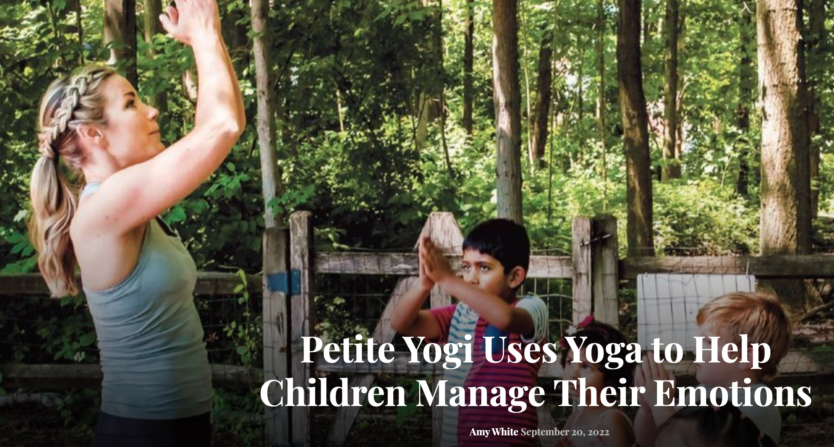Interesting business helping our smallest minds learn how to be mindful of their big emotions.
Want to help kids manage stress while strengthening kindness and creativity? Courtney Loughney, founder of Petite Yogi, recommends yoga.
Parents of Delaware, we see you. Kids are hard. But have you tried yoga? Not for you, but for them. “The benefits of yoga to children across many age groups and populations—from preschoolers to middle-schoolers to kids with special needs—is really remarkable,” says Courtney Loughney, a former behavioral therapist-turned-yogi.
In 2013, she founded Petite Yogi, providing school-based yoga and mindfulness programming after noticing that the kids she worked with in therapy didn’t have a healthy way to manage anxiety. “I knew from my own experience as a former dancer that moving my body and breathing was how I combated my anxiety,” she says.

Courtney Loughney, a former behavioral therapist and the founder of Petite Yogi, says yoga helps children with everything from managing stress to improving sleep. She works with students as young as preschool age, teaching breathing techniques, dramatic play and kindness.
And it’s more than just anxiety: Loughney says yoga helps kids concentrate better, promotes kindness and creativity, and equips them with tools to manage stress. And—bonus—certain techniques can help kids sleep better, too.
“Something that we introduce to our preschoolers is a simple breathing technique to help them sleep or manage big feelings; older students, if they’re anxious at school, can do this too,” Loughney says. “If you imagine tracing one hand with your finger, every time you travel up, you inhale; travel down, you exhale. Five breaths can really reset you, and no one even has to know what you’re doing.”
In terms of creativity, there’s lots of dramatic play in yoga for younger yogis and yoginis. “We’re ‘traveling’ to the zoo, for example, and we’re acting like animals, which sparks lots of inspiration and creativity,” Loughney explains. “In those creative movements, there’s lots of crossing the midline, where you’re using the opposite arm and leg. That uses both sides of the brain at the same time, which is wonderful for development.”
Loughney also incorporates kindness. “We encourage our students not to make comments like, ‘Well, I can do that move, that’s easy.’ It’s not easy for everyone,” she says. “That’s not conducive to yoga, because it’s not a competition—it’s a practice.”
For children with special needs, yoga helps with impulse control, which is something Loughney has seen more children battle post–COVID-19. “There wasn’t anyone who wasn’t impacted by the pandemic, and we can see that in class,” she says. “How we use mindfulness to inform impulse control in a heightened state translates to being able to use these tactics in a calm state.”
Yoga also helps with core strength, another issue Loughney associates with the pandemic. “After the pandemic, there’s been an uptick of ‘W-sitting,’ in which students sit with their knees in front and feet at their hips versus sitting “crisscross yoga sauce, which is a function of a lack of core strength” she explains. “So, we focus there.”
One of her favorite acknowledgements of yoga’s transformative power came after working with students at Ursuline Academy in Wilmington.
“They all weren’t overly excited about yoga,” Loughney remembers. “We did shavasana [a restorative or resting pose] at the end, and typically kids can do this for a minute. But these students…I can’t explain the euphoric vibe. I let them go on for five minutes, and they were just so Zenned out. I could see all the tension from their school day just leave their bodies. What we are here to do is help kids to get back into their bodies and unplug.”

